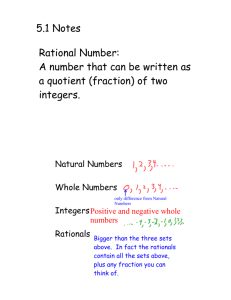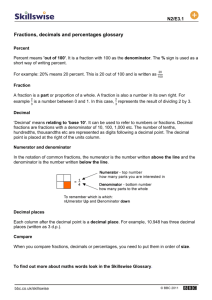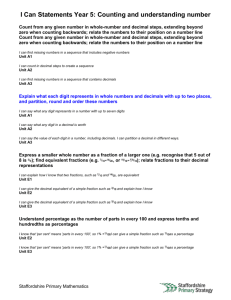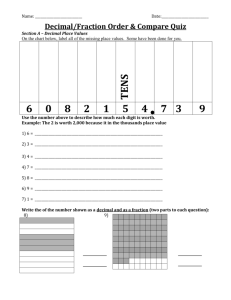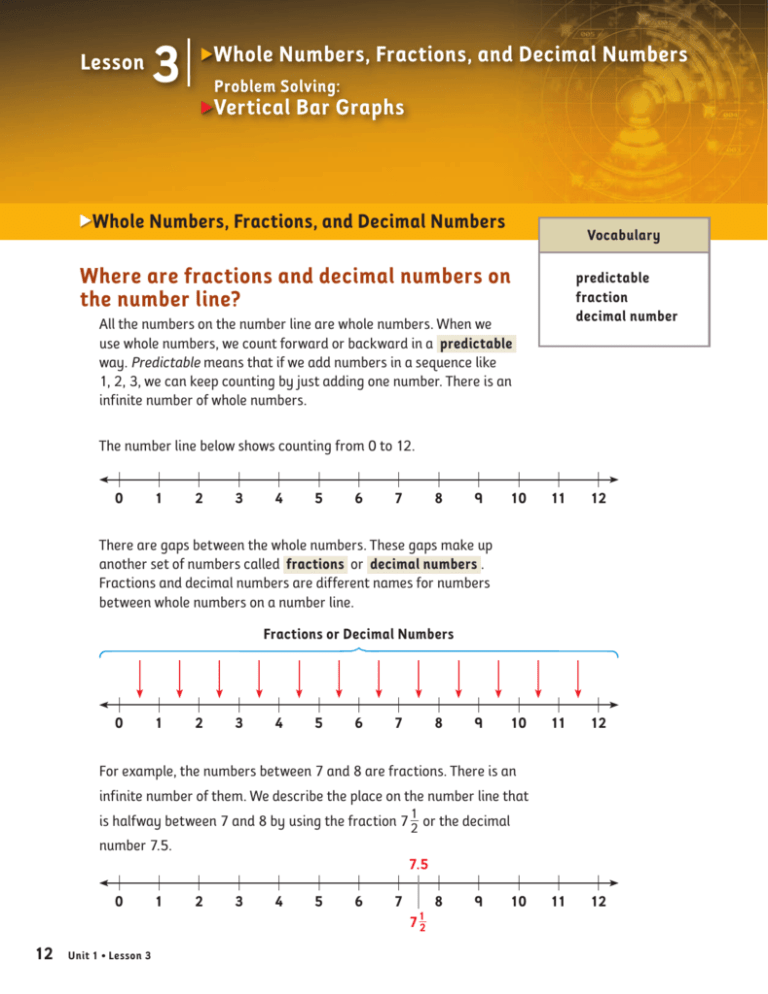
Lesson
3 Whole Numbers, Fractions, and Decimal Numbers
Problem Solving:
Vertical Bar Graphs
Whole Numbers, Fractions, and Decimal Numbers
Vocabulary
Where are fractions and decimal numbers on
the number line?
predictable
fraction
decimal number
All the numbers on the number line are whole numbers. When we
use whole numbers, we count forward or backward in a predictable way. Predictable means that if we add numbers in a sequence like
1, 2, 3, we can keep counting by just adding one number. There is an
infinite number of whole numbers.
The number line below shows counting from 0 to 12.
0
1
2
3
4
5
6
7
8
9
10
11
12
10
11
12
11
12
There are gaps between the whole numbers. These gaps make up
another set of numbers called fractions or decimal numbers .
Fractions and decimal numbers are different names for numbers
between whole numbers on a number line.
Fractions or Decimal Numbers
0
1
2
3
4
5
6
7
8
9
For example, the numbers between 7 and 8 are fractions. There is an
infinite number of them. We describe the place on the number line that
is halfway between 7 and 8 by using the fraction 7 1
2 or the decimal
number 7.5.
7.5
0
12 Unit 1 • Lesson 3
1
2
3
4
5
6
7
7 12
8
9
10
Lesson 3
Example 1
Mark some common fractions and decimal numbers between the
whole numbers 10 and 11.
10
10.25
10.5
10.75
11
10
10 14
10 12
10 34
11
Mark some other fractions and decimal numbers between the whole
numbers 10 and 11.
10
10.33
10.67
11
10
10 13
10 23
11
Fractions and decimal numbers are similar to whole numbers, but
they can be hard to imagine. There are an infinite number of fractions
and decimal numbers between any two whole numbers. When we find
two fractions or decimal numbers, we know there are always others
between them.
Example 2
Find fractions and their matching decimal numbers between the
whole numbers 0 and 1.
0
0.5
0.625
0.75
1
0
1
2
5
8
3
4
1
0
0.5
0
1
2
0.625 0.67 0.75
5
8
2
3
3
4
1
1
These numbers appear in a certain order. For example, 1
2 is smaller than
3
1
3
4 , so 2 comes before 4 on the number line. On the second number line,
1
3
2
1
we see that 2
3 comes between 2 and 4 because 3 is larger than 2 , but
smaller than 3
4.
Unit 1 • Lesson 3 13
Lesson 3
How do we count fractions and
decimal numbers?
An important difference between whole numbers, fractions, and
decimal numbers has to do with counting. When we count whole
numbers, we add 1 to find the next number. We know the number that
comes after 742 is 743 when we count by ones.
This is not the case for fractions and decimal numbers. We are not sure
3
1
what comes after 1
4 . It depends. It could be 8 , or it could be 2 . It could
be any number of other fractions. The same is true for decimal numbers.
What comes after 0.25? It could be 0.251, 0.2511, 0.25111, 0.26, or
any number of other decimal numbers.
A way to make counting predictable is to count by the same amount. If
1
we choose 1
4 , we count by 4 . The same is true for decimal numbers. If
we choose 0.25, we count by 0.25. In this way, we can count forever by
whatever fraction or decimal number we choose.
Example 1
Count by fourths on the number line.
0
0.25 0.5 0.75
1
4
0
14 1
2
3
4
1
1
1.25 1.5 1.75
1 14
1 12
1 34
2
2
2.25 2.5 2.75
2 14
2 12
Apply Skills
Reinforce Understanding
Turn to Interactive Text,
page 8.
Use the mBook Study Guide
to review lesson concepts.
Unit 1 • Lesson 3
2 34
3
3.25
3
3 14
Lesson 3
Problem Solving: Vertical Bar Graphs
How do we use a vertical bar graph to
graph data?
Bar graphs make data easier to see. The table shows the popularity
of different foods. It shows kinds of foods in one column. In the other
column, it shows how many people like each kind of food. In the vertical
bar graph, it is easier to see which food type was the favorite.
Favorite Food
Pizza
Tacos
Hamburgers
French Fries
Burritos
Number of People
12
9
4
2
1
Favorite Foods
14
Number of People
12
10
8
6
4
2
0
Pizza
Tacos
Hamburgers French Fries
Burritos
Types of Food
We can use a bar graph to display data that we collect in many
different ways.
Problem-Solving Activity
Reinforce Understanding
Turn to Interactive Text,
page 9.
Use the mBook Study Guide
to review lesson concepts.
Unit 1 • Lesson 3 15
Lesson 3
Homework
Activity 1
Tell the value of the missing numbers on the number line.
20
20.25
1.
(a)
1
1
4 20 2
(c) 20
40
40.33
40
(b)
2.
216
216.5
216
(b)
199
199.25
199
(b)
3.
4.
21
(d)
3 21
4
(a)
1
3
41
2
3
(c)
217
(a)
1
2 217
(c)
(a)
41
218
1
2 218
199.75
1
4 (c)
(b)
1
2 (d)
200
3
4 200
Activity 2
Use the number line to decide which fraction or decimal number is bigger.
0
0.33
0.25
0
1
1. What’s bigger, 2 or
1
4
1
4?
1
3
1
2
0.5
0.67
1
2
2
3
0.75
1
34
1
2. What’s bigger, 0.67 or 0.5?
3. What’s bigger, 0.5 or 0.25?
2
3
4. What’s bigger, 3 or 4 ?
3
4
Activity 3 • Distributed Practice
Solve.
1.
876
299
577
16 Unit 1 • Lesson 3
2.
794
+ 876
1,670
3.
69
48
3,312
4.
537
8
5. 7q679
4,296
Copyright 2010 by Cambium Learning Sopris West®. All rights reserved. Permission is granted to reproduce this page for student use.

